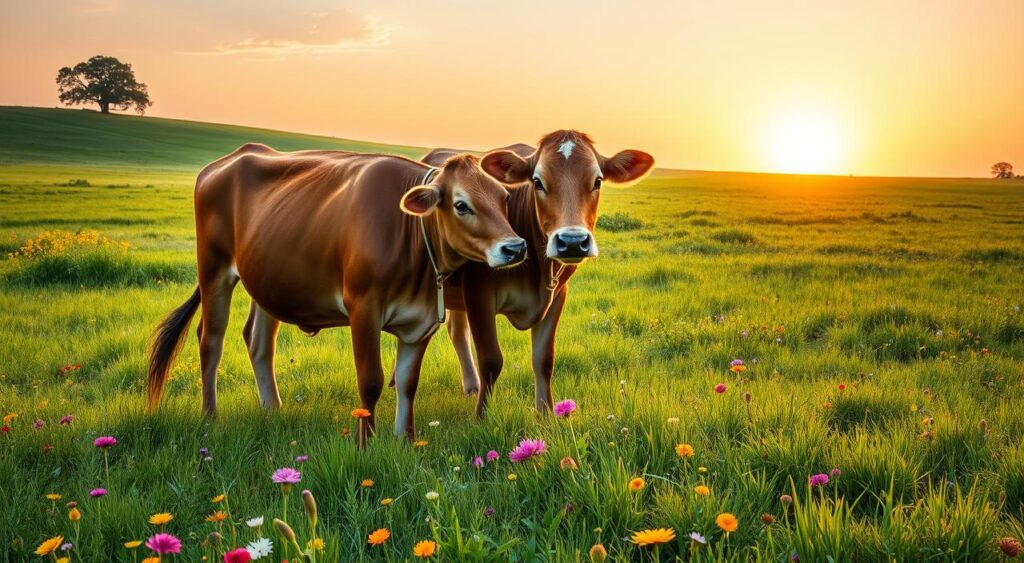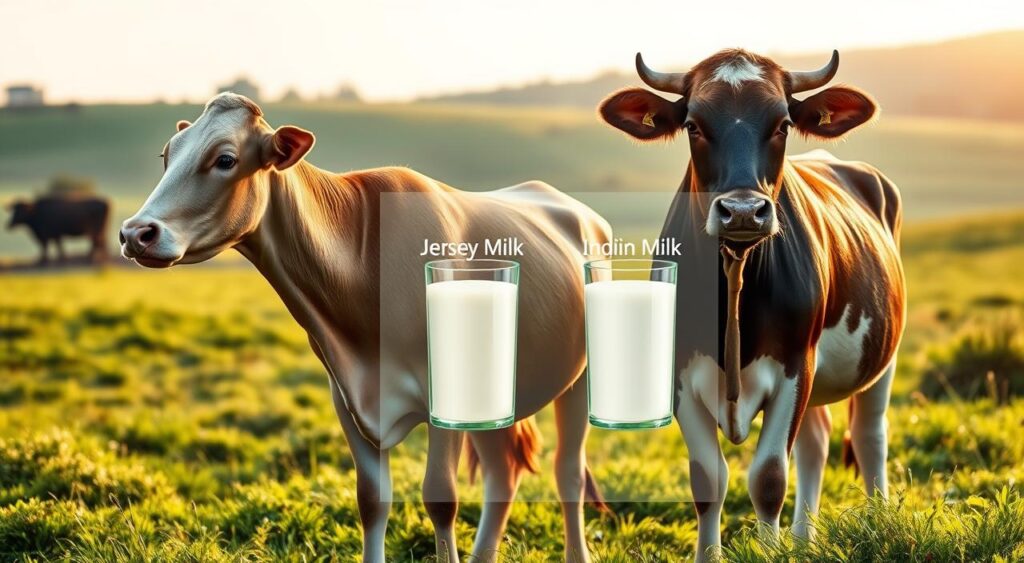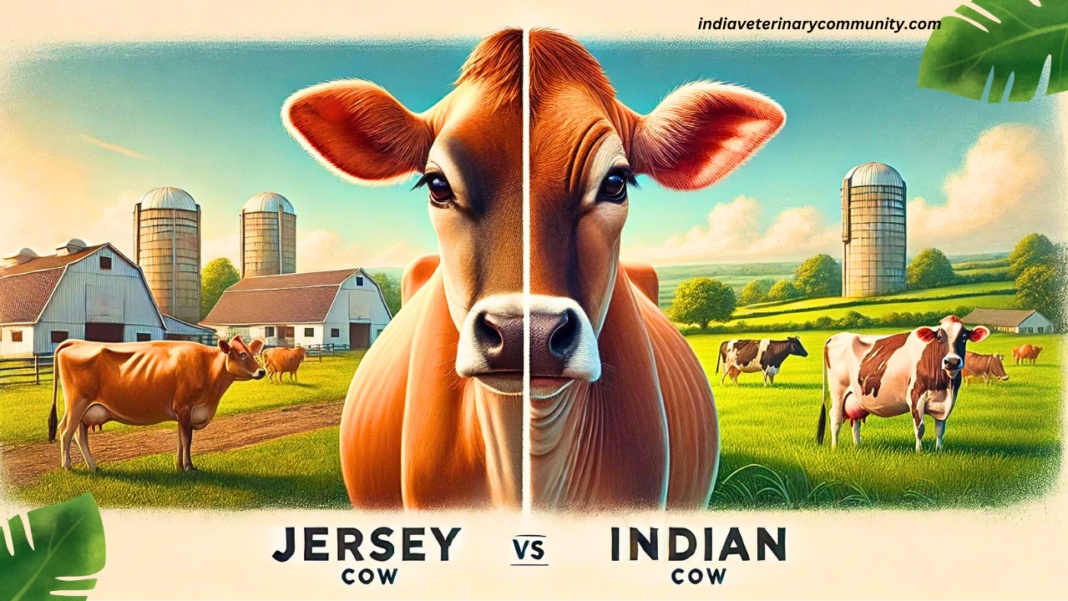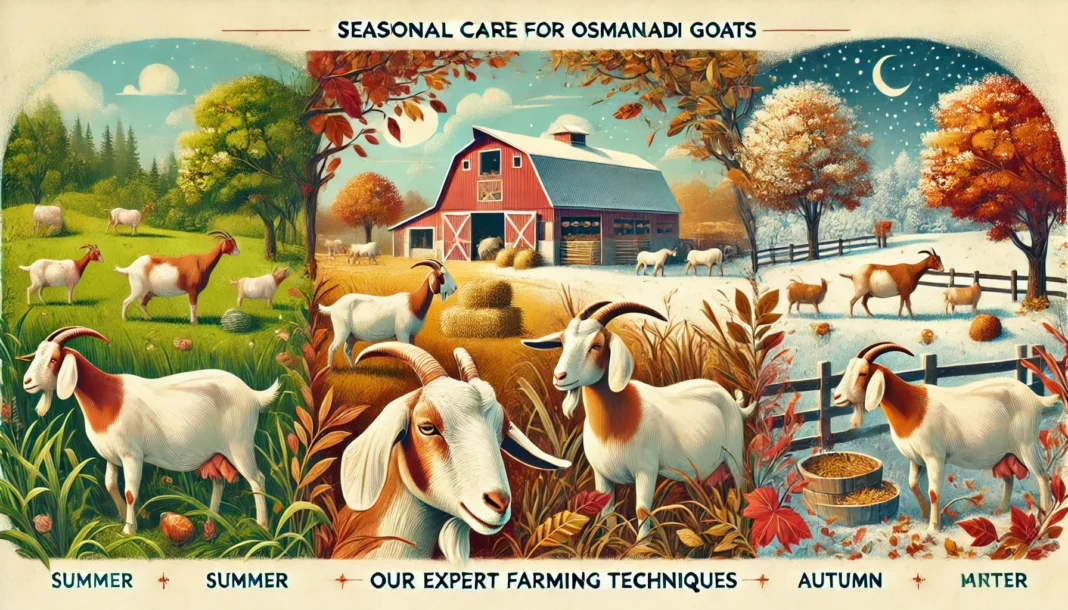India is home to many milch animals, with cows being very special. They are loved and respected in Indian culture and economy. People are curious about the differences between Jersey Cow vs Indian Cow, especially their milk.
This article will explain these differences. It’s important for Indians to know about them.
Key
- Explore the unique characteristics and differences between the Jersey cow and the Indian cow breeds.
- Understand the milk composition, quality, and nutritional profile of these two dairy cattle breeds.
- Compare the milk production and yield capabilities of Jersey and Indian cows.
- Discover the cultural and traditional significance of cows in Indian society.
- Examine the impact of sustainable dairy farming practices on the environment and animal welfare.
Introduction to Dairy Cattle Breeds
Dairy cattle have been key in Indian agriculture and culture for centuries. From the native Desi cows to the famous Jersey breed, they’ve shaped the dairy scene in the subcontinent. It’s vital to understand the special traits and importance of these breeds to appreciate India’s rich livestock heritage.
Significance of Dairy Cattle in India
Dairy cattle are more than just economic assets in India; they hold deep cultural and spiritual value. The milk they produce has been a staple in traditional Indian diets, offering vital nutrients for generations. Additionally, cows are highly revered in Hinduism, with the Desi cow symbolizing Indian heritage and identity.
Overview of Jersey and Indian Cow Breeds
- Jersey Cow: Hailing from Jersey Island, this breed is famous for its high-quality milk, rich in butterfat and protein. Jersey cows are adaptable, making them a favorite among dairy farmers globally, including in India.
- Indian Cow Breeds: India boasts a wide range of indigenous cow breeds, each with its own distinct features. Notable Desi cow varieties include the Sahiwal, Gir, and Rathi, known for their ability to thrive in the Indian climate, resistance to diseases, and high milk yields.
The mix of Jersey cows and Indian breeds has created a vibrant dairy industry. Farmers and consumers look for the best milk quality, yield, and sustainability from these breeds.

jersey cow vs indian cow: Key Differences
The debate between Jersey and Indian cow milk is not just about how much milk they produce. It’s also about the quality and health benefits. Jersey cows may give more milk, but Indian cow milk is often seen as better in terms of nutrition and health.
Milk Composition and Quality
Indian cow milk has more a2 milk protein, which is easier to digest and less likely to cause allergies. It also has a richer fatty acid profile with more omega-3 and omega-6 fatty acids.
Adaptability and Disease Resistance
Indian cows are known for their heat tolerance and disease resistance. They do well in India’s tough climate and diseases. Jersey cows, from a cooler region, might struggle more with heat and diseases.
| Characteristic | Jersey Cow | Indian Cow |
|---|---|---|
| Milk Protein Composition | Higher a1 protein | Higher a2 protein |
| Fatty Acid Profile | Lower omega-3 and omega-6 | Higher omega-3 and omega-6 |
| Heat Tolerance | Lower | Higher |
| Disease Resistance | Lower | Higher |
The differences between Jersey and Indian cows show their unique strengths. It’s important for farmers and consumers to understand these differences. This helps in making better choices for dairy farming and consumption.

Nutritional Profile and Health Benefits
Indian cow milk has a better nutritional profile than Jersey milk. Studies by the National Bureau of Animal Genetic Research show that Indian breeds mainly produce A2 milk. This milk is rich in healthy fats and beneficial proteins.
This unique mix of omega-3 fatty acids and protein helps prevent dairy allergies. It also offers many medicinal properties for better digestive health and brain function.
Protein and Fat Content
Indian cow milk has more protein than Jersey milk. It has more casein and whey proteins. This makes it a better choice for muscle growth and recovery.
The fat content in Indian cow milk is also special. It’s full of omega-3 fatty acids. These are good for the heart and brain.
Medicinal Properties and Allergies
Many studies show the medicinal properties of Indian cow milk. It has anti-inflammatory, antioxidant, and antimicrobial effects. This makes it great for traditional Ayurvedic and homeopathic remedies.
The A2 milk from Indian cows is also less likely to cause dairy allergies. This is good for people with lactose intolerance or milk sensitivities.
| Nutritional Comparison | Indian Cow Milk | Jersey Cow Milk |
|---|---|---|
| Protein Composition | Higher proportion of casein and whey proteins | Lower protein content and less favorable protein profile |
| Fat Content | Rich in omega-3 fatty acids | Higher saturated fat content |
| Medicinal Properties | Anti-inflammatory, antioxidant, and antimicrobial effects | Relatively lower medicinal benefits |
| Dairy Allergies | Less likely to cause allergic reactions | Higher risk of triggering dairy allergies |

Indian cow milk is a better choice than Jersey milk. It’s more nutritious and less likely to cause allergies. Knowing the differences helps consumers choose better and support sustainable farming.
Milk Production and Yield
The Jersey cow is known for its high milk yield, producing 12 to 14 liters per session. The Indian cow, or Desi cow, may not produce as much, but its milk is considered healthier.
Daily Milk Yield Comparison
A Jersey cow can produce 12 to 14 liters of milk daily. In contrast, the Desi cow produces 8 to 10 liters. This difference is due to their genetics and how well they adapt to their environment.
Factors Influencing Milk Production
- Lactation cycle: The stage of the lactation cycle affects milk yield, with the highest production in the middle.
- Feed efficiency: The quality and amount of feed cows get impacts their milk production. Good nutrition is key for high yields.
- Climate impact: Weather, like temperature and humidity, also affects milk production. Cows need to adapt to their climate.
- Dairy farm management: Good herd management, including breeding and health care, boosts milk production in both breeds.
| Breed | Average Daily Milk Yield (liters) | Lactation Period (days) | Protein Content (%) | Fat Content (%) |
|---|---|---|---|---|
| Jersey Cow | 12-14 | 305 | 3.8-4.2 | 4.5-5.2 |
| Indian (Desi) Cow | 8-10 | 240-270 | 4.0-4.5 | 5.0-5.5 |
While Jersey cows produce more milk, the debate is also about milk quality and health benefits. The Desi cow’s milk is seen as healthier, even if it’s less in quantity.
Cultural and Traditional Significance
In India, cows are more than animals. They are symbols of the country’s rich heritage. The desi cow, or the indigenous Indian cow, holds a special place in the hearts and minds of the people. Their milk, known as A2 milk, has been a key part of the Indian diet for centuries.
According to Vedic sciences and many modern researchers, the milk from desi cows is more beneficial than other dairy breeds. Practices like consuming cow urine, especially from desi cows, have been cited for their potential health benefits. Some studies suggest its use in Ayurvedic medicine.
The Significance of Desi Cows
Desi cows are valued for their milk and their role in sustainable dairy practices. These resilient bovines are well-adapted to the Indian climate and terrain. They thrive on locally available forage and require minimal resources.
Their importance in Indian culture is evident in the various ayurvedic cow products derived from their milk, urine, and dung. These products are widely used in traditional healthcare and household applications.
“The desi cow is not just an animal, but a symbol of our cultural heritage. Its milk, urine, and dung have been used in Ayurvedic practices for centuries, and its contribution to sustainable dairy farming is invaluable.”
As India moves towards a more sustainable future, the desi cow significance in the country’s dairy industry and cultural landscape grows. More people are recognizing the value of cow revered in India. They see the need to preserve this integral part of the nation’s heritage.
Breed Characteristics and Physical Traits
The Jersey cow and the Indian cow are two different dairy cattle breeds. Each has its own special physical traits. Knowing these traits helps us see how these cows differ.
Body Weight and Height
Jersey cows come from the Channel Islands. They are smaller than most cows. A Jersey cow is about 4 to 4.5 feet tall and weighs 800 to 1,000 pounds.
Indian cows, like the Sahiwal and Gir breeds, are bigger. They are 4.5 to 5 feet tall and can weigh up to 1,200 pounds. This makes them taller and heavier than Jerseys.
Coat Color and Appearance
- Jersey cows have a golden-brown coat. It can be light fawn or a deeper, reddish-brown.
- Indian cow breeds, like Sahiwal and Gir, have different coat colors. They can be white, gray, or even spotted.
- Jersey cows are slender and graceful. Indian cows are more muscular and robust.
These physical traits make each breed special. They also help the cows adapt and perform well in different dairy farms.
Sustainable Dairy Farming Practices
It’s key to use sustainable methods in dairy farming to keep the environment and animal welfare good. By focusing on pasture-based dairy farming and efficient fodder cultivation, farmers can cut down on carbon footprint. This makes their work more resource efficient.
Pasture Management and Fodder Cultivation
Desi cows do well in pasture-based dairy farming because of the Indian climate. This method helps them graze naturally and cuts down on the need for energy-heavy feed. It also makes dairy farming better for the environment. Growing fodder that’s full of nutrients can make dairy farms more sustainable and productive.
- Use rotational grazing to keep pastures healthy and productive
- Grow a variety of fodder crops that fit the local climate and soil
- Use organic farming to reduce synthetic fertilizers and pesticides
Environmental Impact and Animal Welfare
Choosing sustainable dairy practices helps farmers lower their carbon footprint. It also makes dairy farming better for the environment. These methods also focus on animal welfare, keeping dairy cattle happy and healthy. This is important for their work and life span.
- Use less water and energy by managing the farm well
- Have systems to handle waste and lessen the environmental impact of dairy
- Give dairy cattle comfy homes and access to natural grazing
Switching to sustainable dairy farming is good for the planet and helps the dairy industry last longer. By focusing on pasture-based dairy farming, fodder cultivation, and animal welfare, farmers help make the dairy sector in India more sustainable and resource-efficient.
Economic Implications and Market Trends
The dairy industry economics show a big difference between Jersey cows and Indian cow breeds. Jersey cows are known for their high milk yield. But, the cost of milk production is key to dairy farming’s profit.
Indian cow breeds like Gir and Sahiwal are cheaper to keep. They adapt well to local climates and need less food. This makes them more profitable for farmers in areas with limited resources.
Profitability and Cost-Effectiveness
The profit from dairy farming depends on milk production costs. Studies find that Jersey cows cost up to 30% more to produce a liter of milk than Indian breeds. This is mainly because of their higher feed and healthcare needs.
| Breed | Average Milk Yield (liters/day) | Cost of Milk Production (INR/liter) |
|---|---|---|
| Jersey Cow | 15-20 | 25-30 |
| Gir Cow | 10-15 | 18-22 |
| Sahiwal Cow | 8-12 | 16-20 |
Consumer Preferences and Market Dynamics
More people want dairy products from indigenous cow breeds. They look for milk and dairy that’s nutritious and fits their cultural and environmental values.
This demand has made Desi cow milk and its products like ghee, curd, and paneer more popular. The market for these products is growing. This opens up new chances for dairy farmers and processors who serve this market.
The choice between Jersey and Indian cow breeds has big economic effects in the dairy industry. While Jersey cows give more milk, breeds like Gir and Sahiwal are more cost-effective. The growing demand for dairy from indigenous breeds shows the need to understand market trends and dynamics in the Indian dairy industry.
Conclusion
Desi cow milk is better for health, nutrition, and cultural values. More people are learning about its benefits. This might lead to better dairy practices in India.
Remember, your health needs and values should decide between Jersey and Indian cows. It’s not just about the milk’s quality.
Desi cow milk has many advantages. It’s more nutritious and has medicinal properties. It also holds cultural importance.
Jersey cows may produce more milk, but Desi cows are better for health and the environment. They are a good choice for those wanting sustainable dairy.
When choosing between Jersey and Indian cows, think about what’s important to you. Consider your health, ethics, and the future of dairy in India. Making an informed choice helps the dairy industry and preserves Desi cow culture.
FAQ : Jersey Cow vs Indian Cow
What is the difference between Jersey and Indian cows in terms of milk production?
Jersey cows produce a lot of milk, up to 12-14 liters at a time. Indian or Desi cows make less milk but it’s better for health.
What are the key nutritional differences between Jersey and Desi cow milk?
Desi cow milk has more healthy fats and proteins. It’s also safer for health than Jersey cow milk, known as A1 milk. Desi cow milk is the better A2 milk type.
How do the breeds differ in terms of adaptability and disease resistance?
Desi cows are better suited to India’s climate. They handle high temperatures well and resist tropical diseases. This makes them strong and reliable milk producers.
What is the cultural and traditional significance of Desi cows in India?
Desi cows are more than animals; they symbolize Indian heritage. Their milk has been in Indian diets for ages. Even cow urine, especially from Desi cows, is believed to have health benefits.
How do the physical characteristics of Jersey and Indian cows compare?
Jersey cows are smaller and need less food than Indian cows. They also look different in terms of coat color and appearance.
What are some sustainable dairy farming practices that promote Desi cow milk production?
Practices like managing pastures, growing fodder, and reducing environmental harm support Desi cow milk. These methods align with India’s cultural and traditional values.
How do the economic implications and market trends differ between Jersey and Desi cow milk?
Jersey cows might be more profitable due to their high milk yield. But, the growing interest in Desi cow milk’s health benefits could shift market trends towards more sustainable dairy practices in India.




